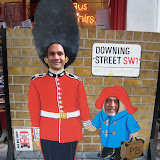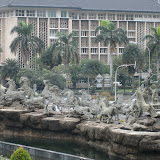Source: K Daigle, Associated Press, 5 June 2011
When Nasir Khan cried out at night from the searing pain of kidney stones, the entire slum could hear him.
A magic healer promised an inexpensive cure through chanting while pinching his side where the kidney stones were lodged, but it only made it worse. His condition became life-threatening, and doctors said he would need surgery for a fourth time.
The operation cost him - and his extended family - their home.
Without insurance and unable to get a loan, they sold the broken brick shack in the industrial north Indian city of Aligarh for 250,000 rupees, or about $5,500. It had been home to the 35-year-old Khan, his four brothers, three wives and 11 children.
"There is no choice. It is my life," Khan said in gasps, writhing atop a crude wooden cot as his relatives hovered helplessly nearby.
He screamed for his mother. He screamed for Allah. He screamed for anyone to deliver him from the pain.
His story is repeated so often across India it evokes little sympathy, yet it represents one of the biggest threats to India's battle to lift its poor up from squalor.
Each year, the cost of health care pushes some 39 million people back into poverty, according to a study published in the Lancet medical journal. Patients shoulder up to 80 percent of India's medical costs. Their share averages about $66 (3,000 rupees) annually per person - a crippling sum for the 800 million or so Indians living on less than $2 a day.
A diagnosis of asthma, a broken leg or a complicated childbirth can mean having to choose between medicine or food, spending on treatment or relying on prayer.
"We are too poor," Khan's uncle Bhuere Khan said. His aunt Rafiquan Mohammed offered another justification for selling the house, as if one were needed: "He has to live. He has small children."
While India boasts an economic growth rate near 9 percent, the wealth has done little to help millions burdened by poverty and disease. The poor, aside from struggling to afford care, also face extreme shortages of doctors and medicines.
The situation is particularly dire in rural areas, where more than 70 percent of the country's 1.2 billion people live. Some desperate patients resort to seeing quacks. Others pay bribes. Many simply don't seek help until it is too late.
The World Bank and other experts have warned that failure to address the country's health care woes could take a toll on long-term growth - especially as two-thirds of the population is under 35 and would form the backbone of India's work force for decades.
Yet India's government spends comparatively little on health care: just 1.1 percent of the country's GDP, a figure that hasn't changed much since 2006 when China was spending 1.9 percent; Russia, 3.3 percent and Brazil, 3.5 percent, according to World Health Organization figures.
"The political will is simply not there yet. We have to help realign the country's priorities," said Dr. K. Srinath Reddy, president of the Public Health Foundation of India and part of a government-commissioned committee recommending reforms.
Statistics that might highlight areas of need are scarce, thanks to erratic case reporting, few autopsies and a tradition of quick cremation that destroys evidence of disease. WHO reports often leave India out for lack of data. A recent study in the Lancet suggests malaria deaths could be 10 times higher than estimated.
India, which says hospital costs impoverish a quarter of all patients, has vowed to raise spending on health to 3 percent of GDP by 2015 and provide universal primary health care - but it's an unfilled promise that's been made before.
The Lancet, in a series on India in January, urged the government to double its pledge to 6 percent by 2020 or jeopardize its ability to shake off poverty.
"What is the point of economic success if there is nothing in it for the population?" Lancet editor Richard Horton said.
"In a short amount of time you can do a lot - if you have the right leadership, the right administration and the public will. India has the people and it has the funds. We'll see if they can do it."
Meanwhile, India boasts a thriving medical tourism industry with shiny private clinics luring tens of thousands of foreigners for everything from bargain tummy tucks to experimental stem-cell treatments in an industry estimated to be worth nearly 100 billion rupees ($2.3 billion).
The pharmaceutical industry is making lifesaving drugs at cut-rate costs, private hospitals are pioneering advances in open-heart surgery and medical schools are churning out physicians eager to work in the West.
For most Indians, however, this is happening in another world.
Uttar Pradesh, one of India's poorest states and home to the padlock-manufacturing city of Aligarh, is a land of barren rural landscapes pocked by crumbling mud huts, wandering cattle and roadside shacks selling potato chips and curry.
Its infant mortality rate - 96 of every 1,000 newborns die - makes it one of the worst places on Earth to be born. The average Indian rate is better at 63 but still grim compared with China's 15 deaths out of every 1,000 births.
The state's leader, Mayawati, who uses only one name, rose from India's lowest caste to power and prominence. She calls health care a top priority. Yet since taking office in 2007 she has spent just $224 million on medicines for the state's 195 million people, while spending $569 million to build memorial parks and statues of leading dalits - also known as untouchables - such as herself.
In rural India, the poor often have to walk kilometers (miles) to reach a clinic, with no guarantee of finding a doctor or the medicine they need. On any given day, at least 40 percent of government doctors are absent - often busy moonlighting for higher pay at private clinics.
Drug supplies are also erratic; last year, India was short 35 million vaccine doses for diphtheria and 30 million for tetanus, a Health Ministry report said.
Many patients simply rely on traditional holistic medicine approaches such as ayurveda, or seek help from quacks, who have become so common the government uses them as information sources on everything from environmental contamination to polio outbreaks.
They advertise in graffiti scrawled across roadside buildings in rural Uttar Pradesh, promising treatments for venereal disease, erectile dysfunction, urinary tract infections - and charging according to what patients can pay.
Cities such as Aligarh, a three-hour drive east of New Delhi over potholed roads, are somewhat better off. They have hospitals, doctors and drugs - though often in short supply.
The government says the nation needs tens of thousands of clinics and 700,000 more doctors.
At Aligarh's Mohan Lal Gautam District Women's Hospital, dozens of women line up each day for a free sterilization procedure that will spare them the risk and cost of having and raising another child.
"It is too much," said 32-year-old Pinky Devi, the frail wife of a rice farmer who said she paid about 20,000 rupees ($450) to have her second daughter in a hospital. "I want to educate my children well. I want a good life. That is why I am here."
The state hospital has only three doctors, who race each day through seeing some 500 patients giving birth, needing operations or seeking treatment for pelvic inflammatory disease and other conditions at subsidized costs.
There are 10 vacancies for doctors, but it is all but impossible to find practitioners who will work for 20,000 rupees (about $450) a month when they can make at least double at a private clinic, Chief Medical Officer Dr. Poonam Sharma said.
"We cannot give the patients good treatment," she said. "They won't get the quality time, most maybe just three minutes." More than half of Aligarh's babies are still born at home, often in unsanitary conditions, Sharma said.
The medical community, eager to increase its numbers, has debated ideas such as training ayurveda or yoga practitioners to give basic care, offering bonuses for working in remote areas and recruiting from Africa.
In the meantime, private health care is booming, with clinics and insurance schemes multiplying and driving up costs.
There are piecemeal efforts to help: a national mission launched in 2005 to improve rural care, and some states offering to cover hospital bills for the poorest.
But patients like Ibne Hasan, diagnosed with HIV two years ago, say they have seen no such benefits.
Once employed in the packaging department at Aligarh's lock factory, 35-year-old Hasan has had to sell his two slum plots and all of his belongings save a threadbare armchair, a few tin pots, a worn mattress and a tiny room he shares with his wife and two children. The money has long been spent.
They are shunned by friends and neighbors. With no electricity or stove, they survive on food Hasan's wife brings from her housekeeping work, and use her monthly 1,100 rupee ($25) wage on AIDS drugs for Hasan and asthma medication for their 5-year-old son, who is far too small for his age and may also have HIV.
"When we can, we buy medicine. I haven't gotten one rupee in treatment," Hasan said, as the listless little boy huddled in the room. Laughing children threw pebbles at the shack from outside. "They make all these promises, but they are only promises. I have seen nothing."











